2004 Hyundai Sonata tires
[x] Cancel search: tiresPage 184 of 208
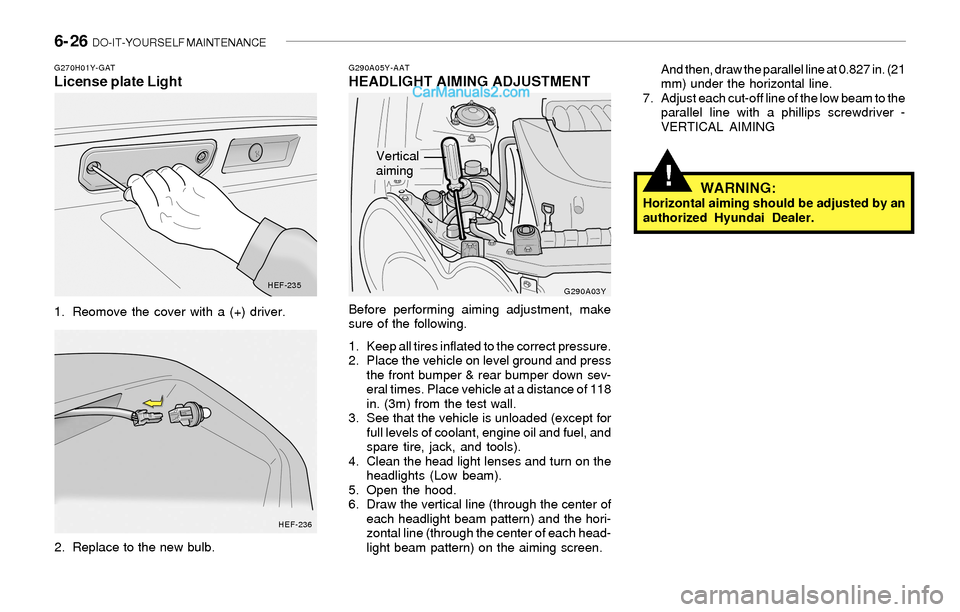
6- 26 DO-IT-YOURSELF MAINTENANCE
!
G290A05Y-AATHEADLIGHT AIMING ADJUSTMENT
Before performing aiming adjustment, make
sure of the following.
1. Keep all tires inflated to the correct pressure.
2. Place the vehicle on level ground and press
the front bumper & rear bumper down sev-
eral times. Place vehicle at a distance of 118
in. (3m) from the test wall.
3. See that the vehicle is unloaded (except for
full levels of coolant, engine oil and fuel, and
spare tire, jack, and tools).
4. Clean the head light lenses and turn on the
headlights (Low beam).
5. Open the hood.
6. Draw the vertical line (through the center of
each headlight beam pattern) and the hori-
zontal line (through the center of each head-
light beam pattern) on the aiming screen.And then, draw the parallel line at 0.827 in. (21
mm) under the horizontal line.
7. Adjust each cut-off line of the low beam to the
parallel line with a phillips screwdriver -
VERTICAL AIMING
WARNING:Horizontal aiming should be adjusted by an
authorized Hyundai Dealer.
G290A03Y
G270H01Y-GATLicense plate Light
1. Reomove the cover with a (+) driver.
2. Replace to the new bulb.
HEF-235
HEF-236
Vertical
aiming
Page 192 of 208

8. CONSUMER INFORMATION
Vehicle Identification Number (VIN) ................................................. 8-2
Engine number ................................................................................. 8-2
Recommended inflation pressures ................................................... 8-2
Snow tires ........................................................................................ 8-3
Tire chains ....................................................................................... 8-3
Tire rotation ...................................................................................... 8-3
Tire balancing ................................................................................... 8-4
Tire traction ...................................................................................... 8-4
When to replace tires ....................................................................... 8-4
Spare tire and tools .......................................................................... 8-5
Warranties for Your Hyundai Vehicle ............................................... 8-5
Consumer Information ...................................................................... 8-5
Reporting Safety Defects ................................................................. 8-7
8
Page 193 of 208
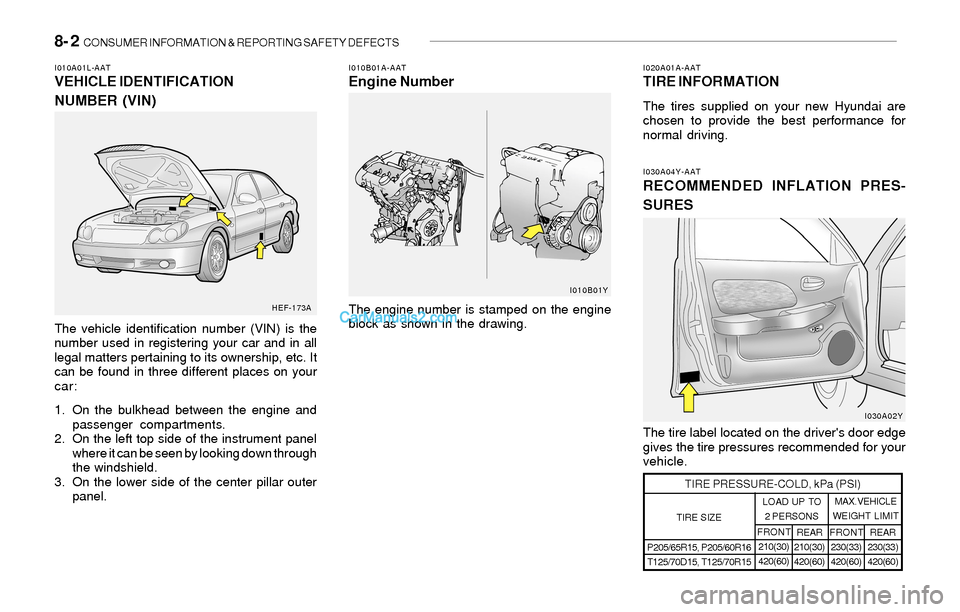
8- 2 CONSUMER INFORMATION & REPORTING SAFETY DEFECTS
I030A04Y-AATRECOMMENDED INFLATION PRES-
SURES
I020A01A-AATTIRE INFORMATION
The tires supplied on your new Hyundai are
chosen to provide the best performance for
normal driving.
I010B01A-AATEngine NumberI010A01L-AATVEHICLE IDENTIFICATION
NUMBER (VIN)
The vehicle identification number (VIN) is the
number used in registering your car and in all
legal matters pertaining to its ownership, etc. It
can be found in three different places on your
car:
1. On the bulkhead between the engine and
passenger compartments.
2. On the left top side of the instrument panel
where it can be seen by looking down through
the windshield.
3. On the lower side of the center pillar outer
panel.The engine number is stamped on the engine
block as shown in the drawing.
The tire label located on the driver's door edge
gives the tire pressures recommended for your
vehicle.
TIRE SIZE
TIRE PRESSURE-COLD, kPa (PSI)
P205/65R15, P205/60R16
T125/70D15, T125/70R15REAR
210(30)
420(60)FRONT
230(33)
420(60) LOAD UP TO
2 PERSONSMAX.VEHICLE
WEIGHT LIMIT
REAR
230(33)
420(60) FRONT
210(30)
420(60)
HEF-173AI010B01Y
I030A02Y
Page 194 of 208
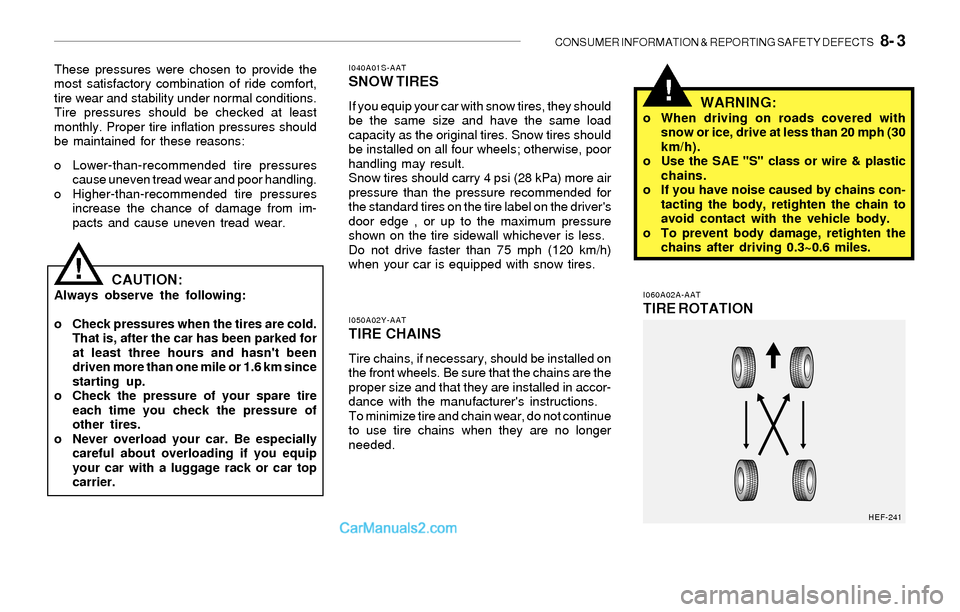
CONSUMER INFORMATION & REPORTING SAFETY DEFECTS 8- 3
!
I050A02Y-AATTIRE CHAINS
Tire chains, if necessary, should be installed on
the front wheels. Be sure that the chains are the
proper size and that they are installed in accor-
dance with the manufacturer's instructions.
To minimize tire and chain wear, do not continue
to use tire chains when they are no longer
needed.
I040A01S-AATSNOW TIRES
If you equip your car with snow tires, they should
be the same size and have the same load
capacity as the original tires. Snow tires should
be installed on all four wheels; otherwise, poor
handling may result.
Snow tires should carry 4 psi (28 kPa) more air
pressure than the pressure recommended for
the standard tires on the tire label on the driver's
door edge , or up to the maximum pressure
shown on the tire sidewall whichever is less.
Do not drive faster than 75 mph (120 km/h)
when your car is equipped with snow tires. These pressures were chosen to provide the
most satisfactory combination of ride comfort,
tire wear and stability under normal conditions.
Tire pressures should be checked at least
monthly. Proper tire inflation pressures should
be maintained for these reasons:
o Lower-than-recommended tire pressures
cause uneven tread wear and poor handling.
o Higher-than-recommended tire pressures
increase the chance of damage from im-
pacts and cause uneven tread wear.
!
WARNING:o When driving on roads covered with
snow or ice, drive at less than 20 mph (30
km/h).
o Use the SAE "S" class or wire & plastic
chains.
o If you have noise caused by chains con-
tacting the body, retighten the chain to
avoid contact with the vehicle body.
o To prevent body damage, retighten the
chains after driving 0.3~0.6 miles.
CAUTION:Always observe the following:
o Check pressures when the tires are cold.
That is, after the car has been parked for
at least three hours and hasn't been
driven more than one mile or 1.6 km since
starting up.
o Check the pressure of your spare tire
each time you check the pressure of
other tires.
o Never overload your car. Be especially
careful about overloading if you equip
your car with a luggage rack or car top
carrier.I060A02A-AATTIRE ROTATION
HEF-241
Page 195 of 208
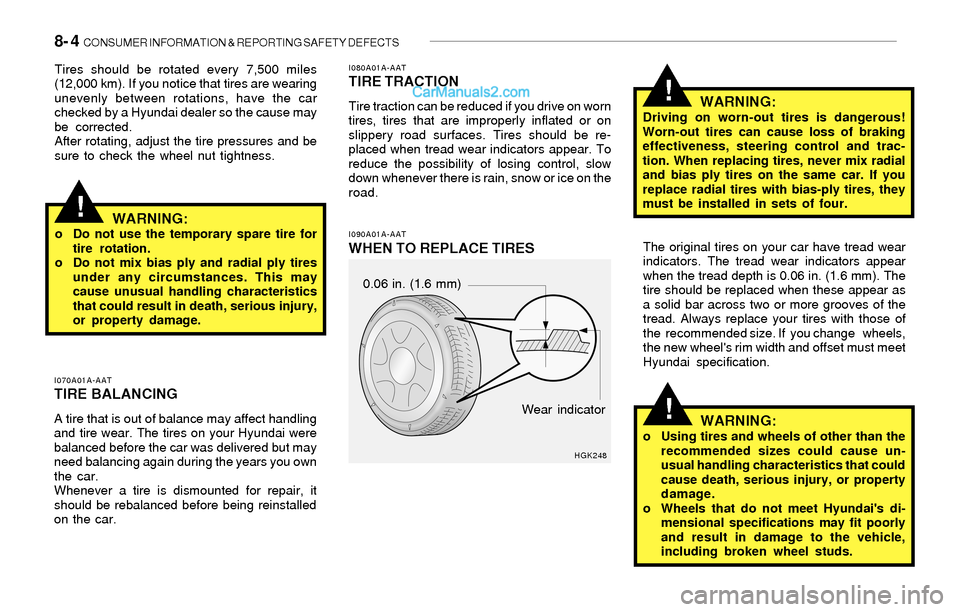
8- 4 CONSUMER INFORMATION & REPORTING SAFETY DEFECTS
!
!
I080A01A-AATTIRE TRACTION
Tire traction can be reduced if you drive on worn
tires, tires that are improperly inflated or on
slippery road surfaces. Tires should be re-
placed when tread wear indicators appear. To
reduce the possibility of losing control, slow
down whenever there is rain, snow or ice on the
road.
I070A01A-AATTIRE BALANCING
A tire that is out of balance may affect handling
and tire wear. The tires on your Hyundai were
balanced before the car was delivered but may
need balancing again during the years you own
the car.
Whenever a tire is dismounted for repair, it
should be rebalanced before being reinstalled
on the car.
I090A01A-AATWHEN TO REPLACE TIRESWARNING:
Driving on worn-out tires is dangerous!
Worn-out tires can cause loss of braking
effectiveness, steering control and trac-
tion. When replacing tires, never mix radial
and bias ply tires on the same car. If you
replace radial tires with bias-ply tires, they
must be installed in sets of four.
The original tires on your car have tread wear
indicators. The tread wear indicators appear
when the tread depth is 0.06 in. (1.6 mm). The
tire should be replaced when these appear as
a solid bar across two or more grooves of the
tread. Always replace your tires with those of
the recommended size. If you change wheels,
the new wheel's rim width and offset must meet
Hyundai specification.
WARNING:o Using tires and wheels of other than the
recommended sizes could cause un-
usual handling characteristics that could
cause death, serious injury, or property
damage.
o Wheels that do not meet Hyundai's di-
mensional specifications may fit poorly
and result in damage to the vehicle,
including broken wheel studs.
HGK248
0.06 in. (1.6 mm)
Wear indicator
!
Tires should be rotated every 7,500 miles
(12,000 km). If you notice that tires are wearing
unevenly between rotations, have the car
checked by a Hyundai dealer so the cause may
be corrected.
After rotating, adjust the tire pressures and be
sure to check the wheel nut tightness.
WARNING:o Do not use the temporary spare tire for
tire rotation.
o Do not mix bias ply and radial ply tires
under any circumstances. This may
cause unusual handling characteristics
that could result in death, serious injury,
or property damage.
Page 196 of 208
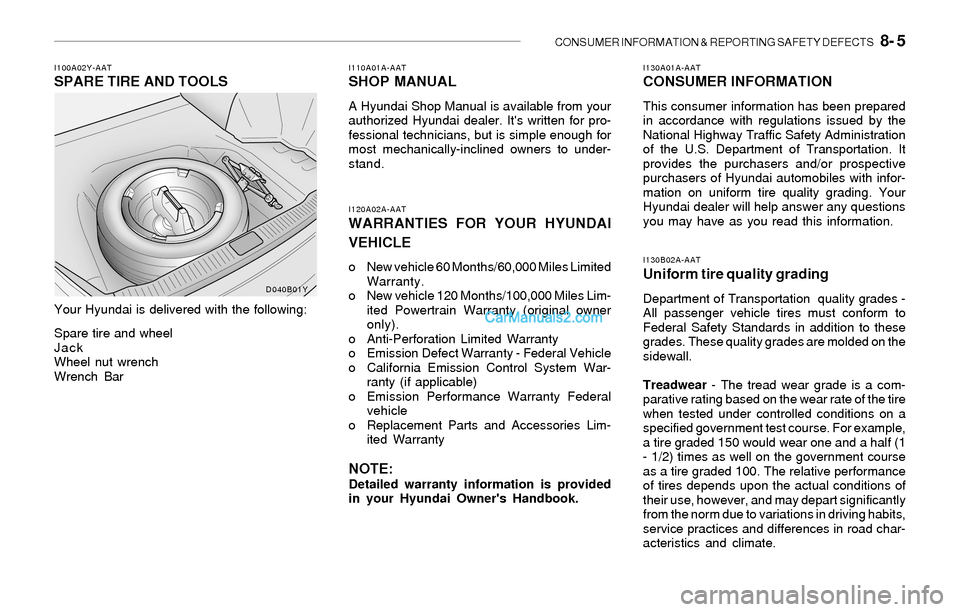
CONSUMER INFORMATION & REPORTING SAFETY DEFECTS 8- 5
I110A01A-AATSHOP MANUAL
A Hyundai Shop Manual is available from your
authorized Hyundai dealer. It's written for pro-
fessional technicians, but is simple enough for
most mechanically-inclined owners to under-
stand.
I100A02Y-AATSPARE TIRE AND TOOLS
Your Hyundai is delivered with the following:
Spare tire and wheel
Jack
Wheel nut wrench
Wrench Bar
I130A01A-AATCONSUMER INFORMATION
This consumer information has been prepared
in accordance with regulations issued by the
National Highway Traffic Safety Administration
of the U.S. Department of Transportation. It
provides the purchasers and/or prospective
purchasers of Hyundai automobiles with infor-
mation on uniform tire quality grading. Your
Hyundai dealer will help answer any questions
you may have as you read this information.
I120A02A-AATWARRANTIES FOR YOUR HYUNDAI
VEHICLE
o New vehicle 60 Months/60,000 Miles Limited
Warranty.
o New vehicle 120 Months/100,000 Miles Lim-
ited Powertrain Warranty (original owner
only).
o Anti-Perforation Limited Warranty
o Emission Defect Warranty - Federal Vehicle
o California Emission Control System War-
ranty (if applicable)
o Emission Performance Warranty Federal
vehicle
o Replacement Parts and Accessories Lim-
ited Warranty
NOTE:Detailed warranty information is provided
in your Hyundai Owner's Handbook.
I130B02A-AAT
Uniform tire quality grading
Department of Transportation quality grades -
All passenger vehicle tires must conform to
Federal Safety Standards in addition to these
grades. These quality grades are molded on the
sidewall.
Treadwear - The tread wear grade is a com-
parative rating based on the wear rate of the tire
when tested under controlled conditions on a
specified government test course. For example,
a tire graded 150 would wear one and a half (1
- 1/2) times as well on the government course
as a tire graded 100. The relative performance
of tires depends upon the actual conditions of
their use, however, and may depart significantly
from the norm due to variations in driving habits,
service practices and differences in road char-
acteristics and climate.D040B01Y
Page 197 of 208
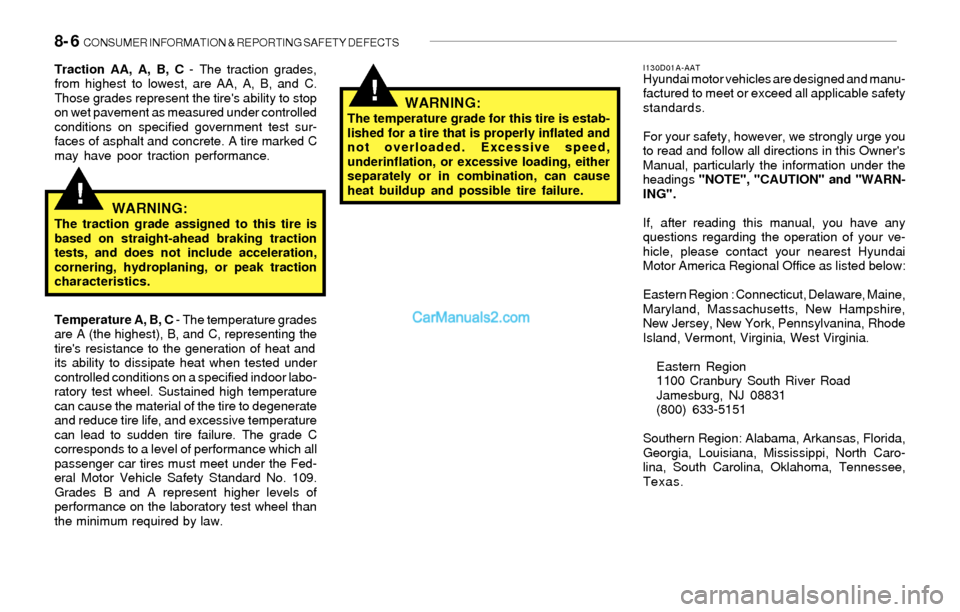
8- 6 CONSUMER INFORMATION & REPORTING SAFETY DEFECTS
!
I130D01A-AATHyundai motor vehicles are designed and manu-
factured to meet or exceed all applicable safety
standards.
For your safety, however, we strongly urge you
to read and follow all directions in this Owner's
Manual, particularly the information under the
headings "NOTE", "CAUTION" and "WARN-
ING".
If, after reading this manual, you have any
questions regarding the operation of your ve-
hicle, please contact your nearest Hyundai
Motor America Regional Office as listed below:
Eastern Region : Connecticut, Delaware, Maine,
Maryland, Massachusetts, New Hampshire,
New Jersey, New York, Pennsylvanina, Rhode
Island, Vermont, Virginia, West Virginia.
Eastern Region
1100 Cranbury South River Road
Jamesburg, NJ 08831
(800) 633-5151
Southern Region: Alabama, Arkansas, Florida,
Georgia, Louisiana, Mississippi, North Caro-
lina, South Carolina, Oklahoma, Tennessee,
Texas. Traction AA, A, B, C - The traction grades,
from highest to lowest, are AA, A, B, and C.
Those grades represent the tire's ability to stop
on wet pavement as measured under controlled
conditions on specified government test sur-
faces of asphalt and concrete. A tire marked C
may have poor traction performance.
WARNING:The traction grade assigned to this tire is
based on straight-ahead braking traction
tests, and does not include acceleration,
cornering, hydroplaning, or peak traction
characteristics.
Temperature A, B, C - The temperature grades
are A (the highest), B, and C, representing the
tire's resistance to the generation of heat and
its ability to dissipate heat when tested under
controlled conditions on a specified indoor labo-
ratory test wheel. Sustained high temperature
can cause the material of the tire to degenerate
and reduce tire life, and excessive temperature
can lead to sudden tire failure. The grade C
corresponds to a level of performance which all
passenger car tires must meet under the Fed-
eral Motor Vehicle Safety Standard No. 109.
Grades B and A represent higher levels of
performance on the laboratory test wheel than
the minimum required by law.
WARNING:The temperature grade for this tire is estab-
lished for a tire that is properly inflated and
not overloaded. Excessive speed,
underinflation, or excessive loading, either
separately or in combination, can cause
heat buildup and possible tire failure.
!
Page 207 of 208
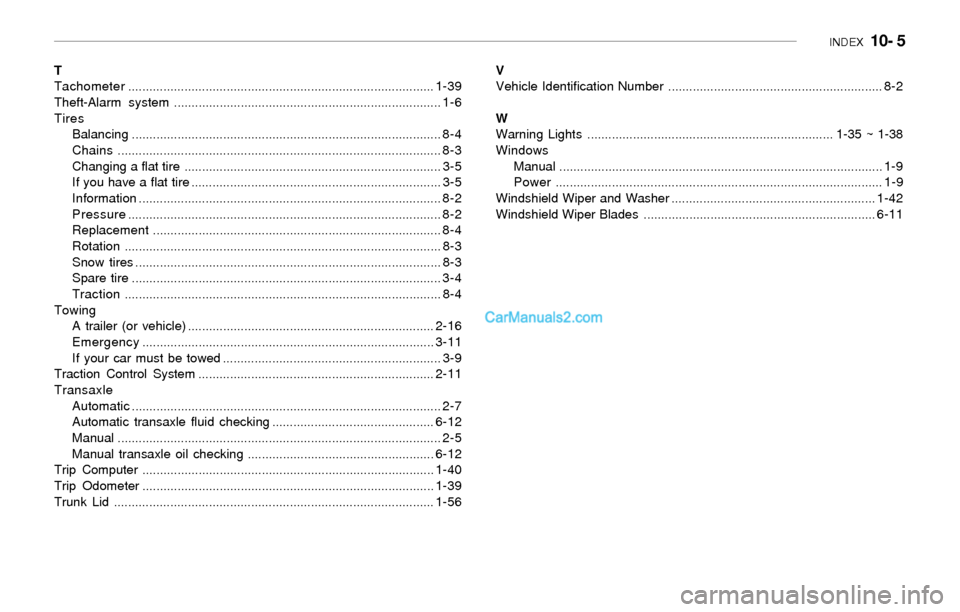
INDEX 10- 5
T
Tachometer.......................................................................................1-39
Theft-Alarm system............................................................................ 1-6
Tires
Balancing........................................................................................ 8-4
Chains............................................................................................ 8-3
Changing a flat tire ......................................................................... 3-5
If you have a flat tire ....................................................................... 3-5
Information...................................................................................... 8-2
Pressure......................................................................................... 8-2
Replacement.................................................................................. 8-4
Rotation.......................................................................................... 8-3
Snow tires....................................................................................... 8-3
Spare tire........................................................................................ 3-4
Traction.......................................................................................... 8-4
Towing
A trailer (or vehicle)......................................................................2-16
Emergency...................................................................................3-11
If your car must be towed .............................................................. 3-9
Traction Control System ...................................................................2-11
Transaxle
Automatic........................................................................................ 2-7
Automatic transaxle fluid checking ..............................................6-12
Manual............................................................................................ 2-5
Manual transaxle oil checking.....................................................6-12
Trip Computer...................................................................................1-40
Trip Odometer...................................................................................1-39
Trunk Lid ...........................................................................................1-56V
Vehicle Identification Number............................................................. 8-2
W
Warning Lights...................................................................... 1-35 ~ 1-38
Windows
Manual............................................................................................ 1-9
Power............................................................................................. 1-9
Windshield Wiper and Washer ..........................................................1-42
Windshield Wiper Blades..................................................................6-11